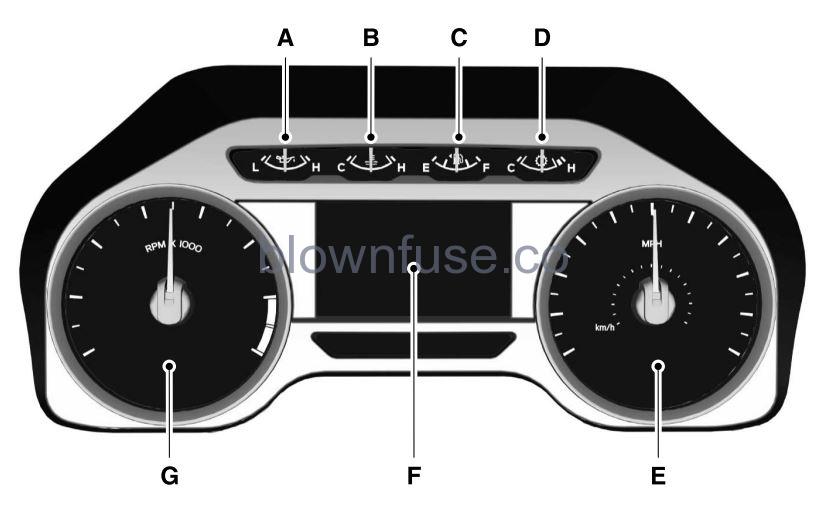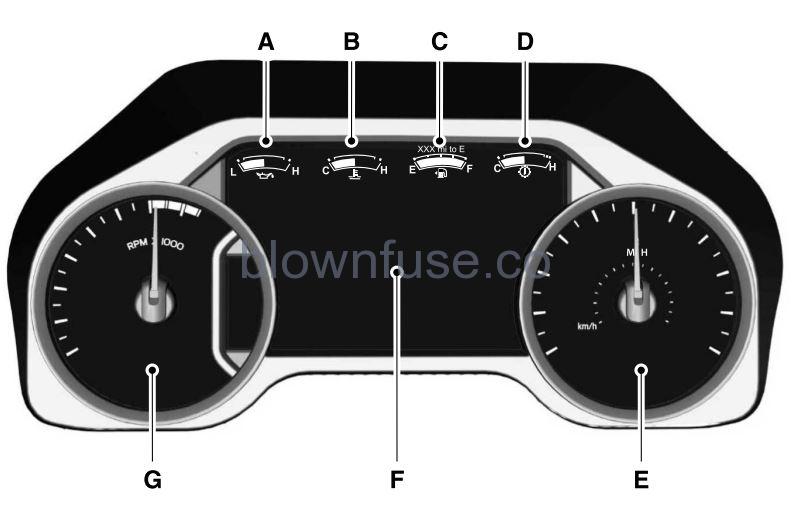2023 Ford E-Seriesb Gauges
GAUGES
2.3 Inch Display

A Engine oil pressure gauge.
B Engine coolant temperature gauge.
C Fuel gauge.
D Transmission fluid temperature gauge.
E Speedometer.
F Information display. See General Information (page 65).
G Tachometer.
8 Inch Display

A Engine oil pressure gauge.
B Engine coolant temperature gauge.
C Fuel gauge.
D Transmission fluid temperature gauge.
E Speedometer.
F Information display. See General Information (page 65).
G Tachometer.
Engine Oil Pressure Gauge
Indicates engine oil pressure. At normal operating temperature, the level indicator is in the normal range. If the pressure gauge falls below the normal range, stop your vehicle, switch off the engine and check the engine oil level. Add oil if needed. If the oil level is correct, have your vehicle checked by an authorized dealer.
Engine Coolant Temperature Gauge
WARNING: Do not remove the coolant reservoir cap when the engine is on or the cooling system is hot. Wait 10 minutes for the cooling system to cool down. Cover the coolant reservoir cap with a thick cloth to prevent the possibility of scalding and slowly remove the cap. Failure to follow this instruction could result in personal injury.
Indicates engine coolant temperature. At normal operating temperature, the level indicator is in the normal range. If the engine coolant temperature exceeds the normal range, stop your vehicle as soon as possible, switch off the engine and let the engine cool.
Fuel Gauge
The fuel gauge indicates about how much fuel is in the fuel tank. The arrow adjacent to the fuel pump symbol indicates on which side of your vehicle the fuel filler door is located.
Note: The fuel gauge may vary slightly when your vehicle is moving or on a slope.
Low Fuel Reminder
A low fuel level reminder displays and sounds when the distance to empty reaches 50 mi (80 km), 25 mi (40 km), 10 mi (20 km) and 0 mi (0 km) for all vehicle keys.
Note: The low fuel reminder can appear at different fuel gauge positions depending on fuel economy conditions. This variation is normal.
Distance to Empty
Indicates the approximate distance your vehicle can travel on the fuel remaining in the tank. Changes in the driving patterns can cause the value to not only decrease but also increase or stay constant for periods of time.
Transmission Fluid Temperature Gauge
Indicates transmission fluid temperature. At normal operating temperature, the level indicator is in the normal range. If the transmission fluid temperature exceeds the normal range, stop your vehicle as soon as possible and verify the airflow is not restricted by snow or debris blocking airflow through the grille. Special operating conditions such as snowplowing, towing, or off-road use may cause higher than normal operating temperatures. See Special Operating Conditions Scheduled Maintenance (page 252).
To lower the transmission temperature into the normal range, alter the severity of your driving conditions. Operating the transmission for extended periods with the gauge in a higher than normal area may cause internal transmission damage. If the gauge continues to show high temperatures, see an authorized dealer.


